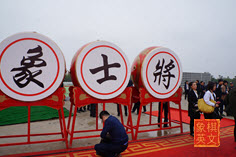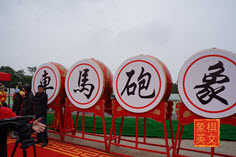Introduction to the Xiangqi (Chinese Chess) Endgame
 Arrrgh… Endgames.
Arrrgh… Endgames.
That was the reaction that the Webmaster had many years ago when starting to learn Xiangqi. In comparison, the Xiangqi Opening and Midgame phase appeared to be much more interesting. Besides, what could you do with so few pieces left on the board? There would not seem to be much to learn about the Xiangqi endgame...
The Webmaster was dead wrong.
The Endgame Phase in Xiangqi is the final phase in the game. Simply put, it would be the moment of life and death after both colors have gone at it. Like the Endgame Phase in International Chess, it is one of the most fundamental skills to learn. In fact, before the study on Basic Kills was divided from the Endgame Phase, this phase was the recommended place to start learning Xiangqi.
The Chinese for Endgames is 残局 (cán jú)whereby the first Chinese character would refer to the remains of something.
Over the years, the Webmaster has published two volumes on practical endgames tabiat, which are available on Amazon.
The topic on Endgames is a huge topic and will be broken down into the following sub-topics for discussion:
- History and Evolution of the Xiangqi (Chinese Chess) Endgame
- Characteristics of the Endgame Phase
- Can the study of Endgames be further classified?
- General Overview of the individual pieces in the Endgame
- How to master the Xiangqi Endgame
- Summary from the Secret in the Tangerine
- Some Literature in English
History and Evolution of the Xiangqi (Chinese Chess) Endgame
Shi Lin Guang Ji, the earliest and still extant Xiangqi manual, contained three boards of Xiangqi. The first two were the records of two short games. The third board on Xiangqi was an endgame composition called Shuang long chu hai (双龙出海势) which demonstrated a cross-check leading to a kill. Click here for the original contents.
Later ancient manuals like the Elegant Pastime Manual from the Ming Dynasty also contained 550 endgame compositions. What was interesting is that during the endgame compositions in this phase usually showed Red winning the puzzle. Ancient manuals from the Qing Dynasty, like The Retreat of the Fragrant Bamboo, One Hundred Variations of Xiangqi, Strategic Considerations, et cetera, started to demonstrate draws as the level of tactics and strategy showed tremendous improvements in the level of play.
In the 1930s and 40s, endgame study was taken to another level. Endgame treatises devoted to particular endgame situations started appearing. Perhaps the most significant were three treatises: the Cannon-Pawn Treatise, the Horse-Pawn Treatise, and the Chariot-Horse Treatise. These three masterpieces laid the foundations for modern endgame day theory.
There were more advances in Endgame Theory after 1956, where endgame tabiat (定式残局) began to appear as an independent branch for study. Further
Endgame tabia would refer to specific situations where the outcome can be predicted if both colors did a perfect play. For example, a horse would be sure to defeat an enemy with only one Advisor, but it could be a draw or a positional win against a lone enemy Elephant.
Today, many new publications overthrow the conclusions of the endgame tabiat from yesteryear. Situations that were initially deemed as draws were recognized as book wins or positional wins.
Characteristics of the Endgame Phase
Like the opening, there have been attempts made to try to define the transition from the Midgame Phase to the Endgame Phase. Although it would be arbitrarily impossible to define the start of the Endgame Phase by the number of moves made, the Endgame Phase do show the following characteristics: (1)
- A marked decrease in material and a relative increase in the space available for movement as compared to the midgame and opening.
- The remaining material strength plays a more significant role in determining the outcome. It would be slightly different from the midgame or Endgame, whereby tempi would have a much more significant influence on the outcome.
- Endgames, as a general rule of thumb, are more affected by tactical play.
- Change in the mobility and ability of different pieces
- Less complicated than the Midgame Phase and the Opening Phase.
Can the study of Endgames be further classified?
 Although endgames generally refer to the last phase in a game of Xiangqi, it can also refer to human-made puzzles, which are better known as Endgame Compositions. The International Chess counterpart would be Studies or Problems. Endgame Compositions are now discussed as a topic on their own, and they will be presented individually on this site.
Although endgames generally refer to the last phase in a game of Xiangqi, it can also refer to human-made puzzles, which are better known as Endgame Compositions. The International Chess counterpart would be Studies or Problems. Endgame Compositions are now discussed as a topic on their own, and they will be presented individually on this site.
Over time, as the study into the Endgame Phase deepened, patterns were identified whereby it was possible to conclude if both players gave the perfect play. These situations are called Endgame Tabia, as mentioned above.
Today, it is recommended to the newcomer that he starts his journey with learning the Basic Kills, followed by the Endgame Tabiat. Although there are several hundreds of Endgame Tabiat, it would be highly recommended that the newcomer focuses on the top fifty.
In Grandmaster Liu Dianzhong's book, the Endgame Phase has also been further classified into Strategy Oriented Endgames and Tactical Oriented Endgames.
Classification and Coding of the types of Endgames
Over the years of classification, the Webmaster devised a classification system to help categorize the various endgame situations.
To facilitate coding and classification of the various endgames, Ithe Webmaster will use the following format:
Red's available pieces (no. of pieces + piece-name) -- end result -- Black's available pieces (no. of pieces + piece-name) -- the number of web pages available for this Endgame (if more than one page is needed).
 For example, 1h bw 1a would mean that one horse is a sure win against one Advisor.
For example, 1h bw 1a would mean that one horse is a sure win against one Advisor.
To make sure that the names are in the same order, the pieces will be placed in the following format:
R > H > C > P(bp or hp) > A > E
车 > 马 > 炮 > 兵/卒 > 士 > 象
Therefore, if there are 2 cannons and 1 chariots, it will be "1r2c", not 2c1r.
The following abbreviations will be used:
- bw= book win,
- pw= positional win,
- d = draw,
- bw = book draw,
- pd= positional draw,
- = when the outcome is dependent on who moves first.
The classification of the pawns presents an issue which the Webmaster has chosen to categorize as:
- bp = bottom pawn (pawn located on bottom rank)
- lp = low pawn (pawn located on throat rank or cannon rank),
- tp = pawn on throat rank,
- hp = high pawn (pawn on enemy pawn rank or a pawn that had just crossed the river).
General Overview of the individual pieces in the Endgame
Maneuvering the pieces correctly is critical in the Endgame. The lack of material and a relative increase in space as compared to the midgame opening phase would mean that different pieces would be used differently. Similar advice can be found in many different books in regards to the role of each piece in their Endgame.
The following is a simple summary of the nature and role of each piece in the Endgame.
 Chariot: The lack of material would imply that there would be more space for the Chariot to move. The scope of the Chariot would increase as it could control more intersections on the board. In the Endgame, the power of the Chariot would increase as compared to the prior phases.
Chariot: The lack of material would imply that there would be more space for the Chariot to move. The scope of the Chariot would increase as it could control more intersections on the board. In the Endgame, the power of the Chariot would increase as compared to the prior phases.
Horse: The power of the horse would increase in the Endgame as there would be less material to impede its movement. When attacking, the horse could become very mobile and attack in many different ways.
To defend against a threatening enemy horse, pawn(s), friendly horse(s), Advisor (s), and elephant(s) are used to limit the movement of the horse. In particular, adopting the Ram-horn Advisors would be a commonly used formation to defend against an enemy horse.
Cannon: The relative lack of material in the endgame phase would mean there would be a lack of cannon mounts. As the cannon is only threatening if there are cannon mounts, the cannon would be less threatening in the Endgame. That is the reason why in the late midgame phase, one of the issues to consider would be the availability of material (usually friendly pieces) to act as cannon mounts. Hence, if there were a friendly cannon entering the Endgame, it would be best to adopt a strategy that would allow the player to have some pieces to act as cannon mounts in the Endgame.
The cannon would not be much of a threat if the only cannon mount it had were his king. Friendly advisors or elephants can act as cannon mounts for the cannon to be functional, and because of their location, the cannon is often moved back to his palace for both attack and defense in the Endgame. There is a Xiangqi saying called 'the Cannon goes home in the endgame,' which would refer to this situation.
Pawn: After much exchange of material in the midgame, the remaining pawns on the board would become game-changers. Their threatening potential would increase substantially. Often, the goal would be to try to maneuver the pawn(s) to the elephant eyes in the enemy palace and the centroid intersection.
An important thing to note is that how far the pawn would have advanced. Generally speaking, pawns that have reached the enemy's throat rank or cannon rank are viable threats that the enemy cannot ignore. However, if a pawn were advanced to the enemy's bottom rank (where it would be fondly known as old pawns), its threatening capabilities would be significantly decreased. It must be pointed out again that there is no such thing as pawn promotion in Xiangqi. Although old pawns have their role in the Endgame, it would generally be discouraged to advance them too far. Hence, it would be important to advance the pawns at the ideal time
Another thing to note about the pawns in the Endgame would be the relation between the enemy king and the pawn. If a pawn was too advanced such that the king could be maneuvered behind the pawn, the pawn would be much less of a threat.
One final thing to note about the pawns is the ability to link them in defense. Linked pawns offer much protection if they can prevent the enemy king from influencing the game.
Advisors and Elephants: Although the roles of the advisors and elephants would still be mainly defensive, their presence or absence in the Endgame could change the outcome. The ability to form various defensive formations is critical. For example, the Ram-horn Advisor Formation is useful against an enemy horse. A full guard (two elephants and two advisors) must be arranged correctly against an enemy chariot. The elephants must be positioned correctly in a '1r vs. 1h2e' situation. There is only one formation that can force a draw, while the rest of the various formations would be a positional win for the enemy chariot.
The lack of an advisor or elephant could also have consequences. For example, the lack of an advisor would mean that the enemy chariots would be a more significant threat. The lack of an elephant would mean that the cannon would be fearsome.
King: As there is much less material on the board, the king would often be called on to assist in an attack by making use of the Royal Rule. Indeed, the outcome of many endgame situations would hinge on the ability of the friendly king to be able to assist in advancing other enemy pieces. Use the king wisely!
How to master the Xiangqi Endgame
The following is the advice collected from many books advising readers on the topic of learning the Xiangqi endgame.
A) Start with the Practical Endgames Tabia
The practical endgame tabia is the accumulation of centuries of experimentation and study of various endgame situations. One MUST master the various ways to win in book win situations and how to hold a draw in draws. Attention must be paid to the details in positional wins and draws. Compare them with similar situations, classify them, and reach conclusions on how each Endgame should be played.
B) Solve endgame compositions
Practice makes perfect. Endgame compositions offer a dizzying array of tactics to learn. Still, they can be classified broadly into those that require the player to be aggressive and those that require the player to adopt a defensive stance. Tactics that are commonly seen would include sacrificing material, trading pieces, and maneuvering the pieces.
Although it would be impossible or rare that the position given in an endgame composition could be seen during over-the-board play, they offer a chance to think out of the box and often provide a source of inspiration.
C) Learn from the experts
View the games played by the experts and learn how they approach each endgame situation. Compare them with the endgame tabiat given in this book. The games played by the grandmasters and masters are considered to be textbook material.
Summary from the Secret in the Tangerine
The Webmaster has decided to redo the introduction to the Xiangqi (Chinese Chess) Endgame Phase. Why learn the Endgame? The Endgame phase of the game is one of the most important phases in the game of Xiangqi, where the final outcome is usually decided. Perhaps the best piece of advice is from the ancient manual, The Secret in the Tangerine. The following translation was from the English version of the book by the author. (2) ...
Advice on the Endgame collected from the Secret in the Tangerine:
"The Endgame is the last stage in a game of Xiangqi. In the beginning, there is much material on the board, and the possibilities are many and confusing.In the Endgame, the material is much less, and it would be easier to learn various principles and draw conclusions that would help one in one's game. Moreover, if one were able to master certain principles in the Endgame, the same principle can be extended and be applied in the opening and midgame, resulting in a bigger gain.
If the Endgame you study is a draw, the emphasis would be on defense.
Arrogant people who attack endlessly will not be able to find the path to victory. In fact, the tables would often be turned on them, and they would often lose the game. Therefore, if there is a possibility to win, you must consider the potential strategies required.
The faint and confused do not know how to win and would draw games that should have been won. Sacrificing material recklessly without consideration would also be detrimental.
The above two mentioned scenarios are the result of an inadequate analysis. Therefore, to be able to learn Xiangqi continually, one must be systematic and precise and learn from the manuals while continuously improving. I (Zhu Jin Zhen) have sieved through the ancient manuals to present to you various endgames that have been categorized as endgames whereby Red can win, and endgames that end in a draw." …
Original text:
东海朱晋桢 进之
棋有残局,补全盘之未备也。全盘子多而难明,残局子少而易悟,尤可取法。况得其一诀,便可触类引伸,其于全盘所裨实倍至。如局本成和,贵乎能守。惟刚愎自用,锐其攻而布其胜,胜不可寻,而反致失中,败且随之。局固可胜,贵乎善谋。彼昏愦不知,馁于进而诿于和,和已自慊而安敢他谋,子并弃之,此皆不审局面之误也。故必确有持循,方可为法是集。余从旧谱殚精毕虑务别雌雄,诚使胜者必胜,和者必和,至无余蕴而后敢录焉,共得百四十局,伸其说者十之五,订其谬者十之三,间亦有窃附云。
Some literature in English
On xqinenglish.com, the Webmaster has collected several important books on the topic. The beginner is advised to go through GM Liu Dianzhong's work on Xiangqi Endgame.
To find how an Endgame Position needs to be played, please refer to Practical Endgames by the late Tu Jingming for various concepts and understand the tabiat.
The Chariot-Horse Treatise, Cannon-Pawn Treatise, and Horse-Pawn Treatise remain the foundations of modern-day endgame theory that must be read by the serious Xiangqi player. These three books have also been published into books to preserve them for posterity.
Cannon-Pawn Treatise: https://amzn.to/3254IT5
Horse-Pawn Treatise: https://amzn.to/3g8PIZt
Chariot-Horse Treatise: https://amzn.to/3kWzbLO
Over the years, the Webmaster has published two volumes on practical endgames tabiat, which are available on Amazon. They contain much more information for the various aspects of the endgame phase that has presented on this site.
For the 1st Volume: https://amzn.to/3kWDtTx
For the 2nd Volume: https://amzn.to/3g8PbXt
DISCLAIMER: This webpage contains products with affiliate links, which means that if you click on one of the product links, xqinenglish.com will receive a small commission. You will not incur any extra cost when buying from an affiliate link.
In a nutshell, Endgames may seem boring in Xiangqi, but they are anything but so.
Master the Endgame, and it would do tremendous wonders for your game.
References
1. 刘, 殿中. 象棋新编教材 象棋残局基础. 北京 : 北京体育大学出版社, 2000. 7-81051-485-7/G.415.
2. Png, Jim Hau Cheng. Ancient Xiangqi Classics: Secret in the Tangerine Volume 1. s.l. : Jim Png Hau Cheng, 2017. 978-957-43-4459-8.
3. Png, Jim Hau Cheng and Chai, Vincent Wen Xuan. Understanding the Elephant A Xiangqi Primer Part 3B: Endgame Introduction & Endgame Tabia 2. s.l. : Jim Png Hau Cheng, 2018. 978-957-43-5820-5.
4. Png, Jim Hau Cheng. Lexicon of Xiangqi (Chinese Chess) Terms in English. Taipei : Jim Png Hau Cheng, 2017. 978-957-43-4707-0.
5. Png, Jim Hau Cheng and Chai, Vincent Wen Xuan. Understanding the Elephant A Xiangqi Primer Part 3A: Endgame Introduction & Endgame Tabia. Amazon : Jim Png Hau Cheng, 2018. 978-957-43-5819-6.
